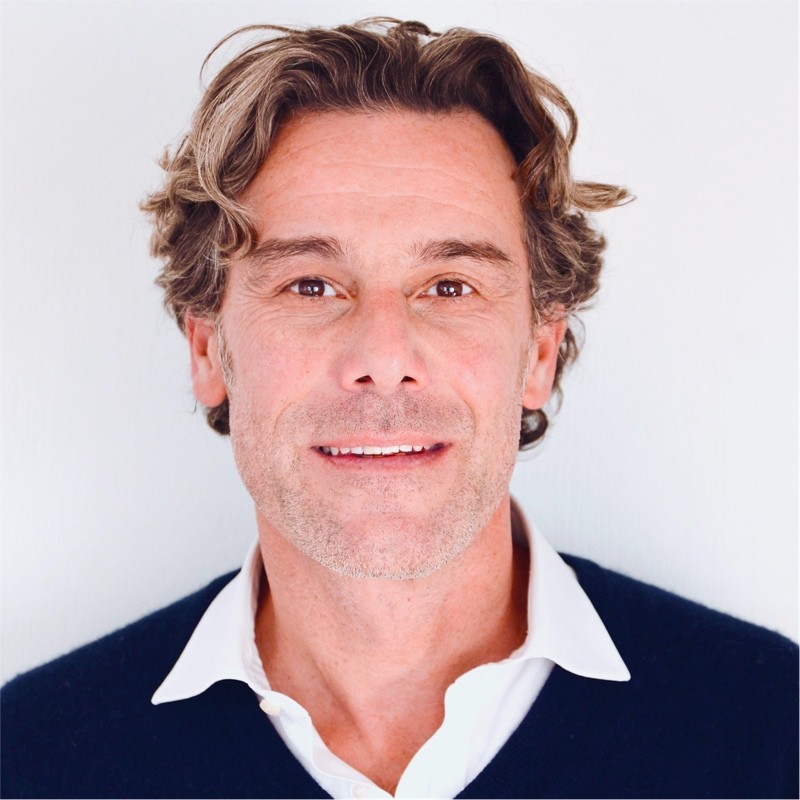News
The Rise of Blockchain-Powered Video Streaming: An Exclusive Interview with Replay CEO Michael Jelen

The video streaming landscape is now at a crossroads. Traditional platforms continue to play by their own rules, and there are palpable concerns about transparency and creator compensation. However, with blockchain technology offering a revolutionary approach to streaming and promising a more just and equitable video economy, is the future of traditional video streaming hanging in the balance?
Curious about this new paradigm, Olayimika Oyebanji turned to Michael Jelen, the new CEO of Replay, for valuable insights into the emerging frontier of video streaming.
Can you tell us briefly about yourself and your journey to web3?
I started my career in traditional financial advisory. I worked on the Madoff investigation and the Lehman Brothers bankruptcy in the United States. After seeing some of the challenges and flaws of the traditional financial system, I moved to Europe where I spent about 10 years working with large financial institutions, mainly dealing with OFAC compliance, specifically designated nationals and various types of sanctioned lists for USD-denominated transactions in the SWIFT banking system.
So, I got to see a lot about KYC and some of the things that we’re currently struggling with regulation in the cryptocurrency space today. All of those things have really led me to be open-minded about creating a new financial system if and when that opportunity presents itself.
And the first time I had an opportunity to see that in the cryptocurrency space was when I was working in Abu Dhabi helping write the blockchain adoption policy and strategy. And while I was there, that was my first opportunity to dream big and see what was possible with this technology, and then during COVID, I spent some time in the US working with different DAOs and protocols that were focused on decentralization and empowering people away from big financial institutions. And that eventually led to me working with a lot of different clients in the consulting space, one of which was Replay.
What are traditional video streaming platforms and how do they differ from decentralized models?
Major traditional video streaming platforms include well-known names for curated content like Netflix, AppleTV, and HBO, as well as user-generated content like YouTube. While compensation models and terms vary between these platforms, the terms are set by these large entities, dictating when, how much, and how often creators are paid for their work. In many cases, payments take 9-12 months, and in some cases, creators must meet a minimum before they are paid. Analytics vary from platform to platform, but providing granularity and transparency into viewer analytics is not a priority.
Replay, as a leader in the decentralized streaming space, pays creators immediately when any content is watched. Blockchain provides transparency and puts the role of content selection, fee structure, and roadmap in the hands of the community. It also allows the community to create their own content or derivative content, which is something we have been moving toward lately and see as an exciting future for content streaming.
Besides limited transparency, what are the other shortcomings of traditional video streaming services?
As I have previously highlighted, other challenges are the remuneration model for creators, censorship and centralized curation.
We want to get to a point where we don’t have permissions anymore, where anyone can upload anything, much like YouTube does. So that’s something we’re moving toward and I think it’s going to be really important to allow the community to take control of curation.
Real-time licensing and payments are a hallmark of blockchain streaming. How does this system work from the perspective of both creators and viewers?
Take the RPLAY token as an example. It is the foundation of the ecosystem that connects content creators, viewers, advertisers, AI tools, and any other participants in the ecosystem. As AI becomes more and more important as a method of creating new content, it is important that derivative content properly attributes value and rewards the original creators, which is not the case with most AI at the moment. These innovative licensing structures benefit creators and provide a flexible framework for monetizing community-driven or AI-generated derivative content.
Is there room for traditional and decentralized models to coexist?
Of course, there is room for collaboration and coexistence! It is up to users to vote with their feet, and a competitor is just a click away. Whoever brings the best content to the table wins. Replay is creating the most creator-friendly environment for videos, which will attract the strongest creators, thus providing the best content to our community.
What can you tell us about the founding of Replay and your appointment as the new CEO?
While I wasn’t at Replay when it was founded, I’ve been working alongside the team for over six months and am no stranger to the company. The transition to CEO has been a very natural one, as Krish and Dan have spent more time building the AI capabilities that will underpin many of Replay’s future AI creation tools, while Maddy continues to lead our incredibly powerful engineering team. I’m inspired every day by the team and their capabilities and honored to be here.
I am super excited to be here. I think I have some really unique skills that I bring to the table both in terms of cryptocurrencies, web3 networks and relationships to be able to raise capital and coordinate with different blockchains and develop strong partnerships, taking us to the next phase of growth that we are currently involved in.
I also have a lot of contacts in the traditional film industry and I think as we try to make Replay the best environment for people to build in, it’s going to be critical to have those people on our side as trusted allies and provide them with the platform on which they can build and create new content. So, bringing all of these unique skill sets to the table, I’m very proud to be a part of this organization; the entire team is great and fun to work with.
What are some of the key aspects that decentralized models need to address to be successful in the long term?
I think the biggest one is governance and leadership. Anyone will tell you that building a difficult, complex product in a decentralized way is basically impossible. The common example that everyone uses is the iPhone. Like if you had a decentralized organization, you wouldn’t have the leadership and the vision from the top to achieve something that’s so radically transformative. And I think we’re in the same situation with Replay.
So for that reason, we’re starting more centrally to build the infrastructure, execute the vision, and get it to a critical mass point where everyone else can pick it up and run with it. Our plan is to build it centrally, which we’ve done, get to a huge amount of adoption, and then continue to decentralize that protocol and allow others to take it from there.
We want the community to be able to shape what content is allowed in, what content is not allowed or interesting on the platform, and also create that toolset for creators to be able to create the best content as quickly as possible, so. We need everyone. This is a team effort. It just starts with a clear, communicated, centralized vision, and then we decentralize and give the decision-making to the community.
How do you face these challenges?
It’s pretty simple: start centrally to achieve the mission, then decentralize and hand it over to the people. It’s worked for many other protocols and will continue to evolve.
Can you tell us a success story?
Cyko KO. This is a comic book and the cast of Napoleon Dynamite and the creator is Rob Feldman, who I actually created a Twitter space with. What they did was see if we could do a kind of end-to-end monetization experiment to create new content. So the first thing we did was crowdfund it by selling NFTs, which gave people credit for being producers.
So at that point, those people with that NFT would have limited viewing opportunities so they could be the first to see that content when it came out. We also trained AI models on that content so we could create derivative content off of it. So that would be and I’ll also send you a demo of that so you can check it out. But you could type into a chatbot, “hey, create me a new scene or create me a trailer where a psychopath fights a giant spider.”
And that’s the same kind of thing that would allow us in the future to say, hey, “I want to see scene number one, but tell it from this other character’s point of view.” The possibilities are endless, but we’ve seen that as a proof of concept, we can do that and execute it, and it’s a very exciting technology.
What this means as a success story, and why it’s so important, is that we can go all the way from an idea through crowdfunding, through creation, have a decentralized group of individuals who have funded and created this thing and then create derivative content, all of which can be monetized. And every single time someone watches this, everyone involved can get compensated and paid for it. It’s radical and it’s like a Kickstarter for video content. We’re just scratching the surface. But I think it’s an extremely exciting, good example and something that we’re very excited to continue to develop for future creators.
Any words of farewell?
The main thing I want to focus on here is that crypto and blockchain technology as a whole is the opportunity to give power back to the people. The video streaming world is highly centralized. You’re dealing with a handful of players like Netflix, YouTube, etc., and it’s very difficult for a small creator or an independent creator to be able to fight or negotiate with that.
Replay recognizes that with tools like I, more and more people can become creators and everyone is freelance. We are all working on different projects.
Never before have we had the opportunity for these people to come together and create independent content of the same caliber or a caliber that is highly driven by Tier 1 that people want to watch. And now that we have that ability, there needs to be a distribution channel that is creator-friendly, that rewards these people, and that also provides them with any kind of technology or AI tools to enable them to do their work better and faster.
It’s also community-driven, and people and communities will set the precedent for what kind of content they want to watch. So if you have a group of people who are interested in taking their own life or telling their story and using text-generative AI on video, they can create content, publish it, watch it, and monetize it. And so anyone becomes a creator. We cater to both high-end creators, and people who are interested in going through a different monetization platform, and every single creator, and that’s what Replay is all about. We’re incredibly excited about the power that blockchain technology provides, and we can’t wait to be the platform that brings that to the world.
News
Blockchain Technology Will Transform Water Access and Management Globally

Disclosure: The views and opinions expressed here are solely those of the author and do not represent the views and opinions of the crypto.news editorial team.
Access to clean water is a basic human need, yet billions of people around the world still struggle to get it. According to the World Health Organization, over 2 billion people live in countries suffering from severe water stress, and this number is expected to continue to grow due to climate change and population growth.
Traditional water management systems have struggled to address these challenges, often hampered by inefficiencies, lack of transparency, and misallocation of resources. Blockchain technology offers a promising solution to these challenges, providing equitable access and sustainable use of this crucial resource.
The current state of water management
Water management today faces several pressing issues. Inefficiencies in water supply, distribution, and use, coupled with a lack of real-time monitoring, often result in resource waste and misallocation. Many water sources fail to realize their full potential due to infrastructure and financing shortfalls. For example, the Environmental Protection Agency (EPA) report indicated that the United States would need to invest $625 billion over the next 20 years to repair, maintain and improve the country’s drinking water infrastructure due to aging pipes and other infrastructure problems. Additionally, in the United States alone, household leaks can to waste nearly 900 billion gallons of water per year nationwide. This is equivalent to the annual domestic water consumption of nearly 11 million homes.
Furthermore, corruption and mismanagement of water resources can cause unequal distribution, with disadvantaged communities often bearing the brunt of water scarcity. For example, South Africa is struggling with myriad challenges to its water security: drought, inadequate water conservation measures, outdated infrastructure, and unequal access to water resources. The country faces significant water scarcity, with demand expected to outstrip supply by 2030, creating a projected gap of 17%.
Furthermore, the global water industry is highly monopolized, with a few key players controlling a significant share of the market. These companies exert substantial influence over the water supply chain, often prioritizing profit over equitable distribution and environmental responsibility. This concentration of power can lead to inflated prices and limited access for vulnerable populations. The global bottled water market alone is projected to reach $509.18 billion by 2030, with these large companies capturing a significant share of revenue. This monopolization exacerbates existing inequalities in water access and highlights the need for more decentralized and community-driven water management solutions.
Source: Grand View Search
The potential of blockchain in water management
Blockchain technology can address these issues by providing a transparent, secure, and decentralized platform for water resource management. This approach offers several advantages:
- Transparency and accountability. Blockchain’s immutable ledger ensures that all transactions and data entries are transparent and cannot be changed once recorded. This transparency can reduce corruption and ensure that water resources are allocated fairly and efficiently. For example, blockchain can be used to track water usage from source to end user, providing a clear record of how water is distributed and used. This level of transparency can help hold authorities accountable and manage water resources sustainably.
- Efficient resource management. Blockchain can facilitate the creation of smart contracts, which are self-executing contracts with the terms of the agreement written directly into the code. These contracts can automate water distribution based on real-time data, directing water to where it is needed most. For example, smart contracts could be used to manage urban water supply systems, automatically adjusting water distribution based on real-time consumption patterns and demand. This can help optimize water use, reduce waste, and ensure that households and businesses receive the right amount of water at the right time.
In Dubai, the Dubai Electricity and Water Authority (DEWA) has implemented a blockchain-based smart water network initiative as part of its broader smart city strategy. This project integrates blockchain technology with IoT sensors to monitor water usage in real time, manage distribution, and detect leaks. The decentralized ledger ensures data integrity and transparency, enabling more efficient water management and reduced waste. DEWA’s initiative aims to improve sustainability and resource management in the rapidly growing city, highlighting the potential of blockchain to support urban water management and conservation efforts.
Community participation and ownership
Through blockchain, individuals can directly control and monetize their access to water resources, eliminating the need for third-party intermediaries. This direct control model allows local communities to make collective and transparent decisions about their water use. By managing their water directly from the source, communities can tailor water management practices to their specific needs, promoting equitable distribution and encouraging a sense of accountability and stewardship.
Additionally, future models could allow people to monetize their access to water through web3 technologies. For example, a community-to-business (C2B) model could allow people to sell water directly to companies. In this model, people do not have to own the water directly, but can profit by staking their tokens during event sales pools. This approach not only supports sustainable water management, but also creates economic opportunities for community members. Additionally, a “Burn to Secure” protocol can be used to provide water allocation rights. This protocol provides a true sense of water security and financial opportunity by allowing people to redeem their rights. This system not only secures future water allocations, but also increases token scarcity and value.
Additionally, a pure sense of investment is achieved through investments in water sources. This leads to potential financial returns and dividends by addressing the inefficiencies in water supply mentioned above. By investing to finance infrastructure projects, such as building factories and improving distribution systems, more water can be brought to communities, creating additional economic opportunities.
Monetizing water access through the C2B model, the “Burn to Secure” protocol, and investments in water sources all generate economic benefits for the community, promoting a more equitable and efficient water management system.
Overcoming challenges
While blockchain technology has the potential to improve water management, there are challenges to its adoption. The complexity of blockchain systems and the need for technological infrastructure can be barriers, especially in developing regions. Additionally, there are concerns about the significant energy consumption of blockchain networks. However, technological advances and the development of more energy-efficient blockchain solutions are helping to alleviate these concerns. Additionally, education and capacity building are key to ensuring stakeholders understand how to effectively use blockchain technology. Governments, NGOs, and private sector partners need to work together to provide training and support to communities and water management authorities.
Blockchain technology offers a practical and effective means to improve water management. In addition to addressing inefficiencies, blockchain empowers communities, promotes sustainable practices, and opens up new economic opportunities through models like community-to-business (C2B). As we face the growing challenges of climate change and population growth, blockchain is not only an innovative solution, but represents a fundamental shift in the way we manage and value water resources. Adopting blockchain in water management is essential to creating a sustainable and equitable future by changing the way we interact with and protect our most vital resource.

Jean-Hugues Gavarini
Jean-Hugues Gavarini is the CEO and co-founder of LAKE (LAK3), a real-world asset company leveraging blockchain technology to decentralize access to the global water economy. LAKE aims to ensure access to clean water for all, protect water resources, and deliver water to those in need through innovative technologies. Jean-Hugues has a diverse career spanning the luxury, fashion, and footwear industries. His career path includes notable successes at Mellow Yellow, Cremieux, and Tod’s. Raised between Silicon Valley and the French Alps, Jean-Hugues has always been immersed in technology and freshwater resources. In 2018, Jean became the CEO of Lanikea Waters, a water solutions entity based in the French Alps. In 2019, the concept of LAKE was born, embodying his commitment to innovation and sustainability.
News
Blockchain and AI Expo 2024

With rapid advances in the world of AI and blockchain, there are opportunities to leverage the security and transparency features of blockchain to improve the reliability and trust of AI systems and data transactions.
Explore the synergy of these advanced technologies in virtual mode Blockchain and AI Expowhich takes place on October 31, 2024 TO 10:00 GMT.
The event features cutting-edge presentations led by leading experts in evolving fields. Presentations are set to explore opportunities and challenges in the fusion of blockchain and AI, real-world applications, ethics, innovations in environmental sustainability, and more!
Gain a comprehensive understanding of how these technologies can synergistically drive innovation, optimize operations, and promote strategic growth opportunities. Develop your knowledge to facilitate informed decision making and give your company a competitive edge in the growing technology landscape.
News
Nigeria Eyes National Blockchain Nigerium for Data Sovereignty

Nigeria is keeping an eye on a new native blockchain network to protect the country’s data sovereignty.
According to local media, a team from the University of Hertfordshire has proposed the new blockchain, Nigeriato the National Information Technology Development Agency (NITDA).
Chanu Kuppuswamy, who leads the team, argued that relying on blockchain networks whose developers are located in other regions poses national security risks to the Nigerian government. He further said that Nigerium would allow the West African nation to customize the network to meet specific needs, while also promoting data sovereignty.
In his presentation, Chanu cited the recent migration of Ethereum to test of participation (PoS) consensus as an instance in which no Nigerians were involved but whose impact is far-reaching.
“Developing an indigenous blockchain like Nigerium is a significant step towards achieving data sovereignty and promoting trust in digital transactions in Nigeria,” he said.
While receiving the proposals in Abuja, NITDA’s Kashifu Abdullahi acknowledged the benefits a local blockchain would bring to Nigeria, including increased security of citizens’ data.
However, a NITDA spokesperson later clarified that Nigerium is still at the proposal stage and that the government has not yet decided whether to proceed or not.
“The committee is still discussing the possibility with stakeholders. Even if a decision is finally made, there is no guarantee that the name will be Nigerium,” the spokesperson told the media.
Nigerium’s reception in the country has been mixed. Some, like financial analyst Olumide Adesina, To say the network is “dead on arrival”. He believes the Nigerian government’s poor record in following through on its big technology plans will claim another victim. He pointed to the eNaira as a missed opportunity whose chances of success were much higher than those of Nigerium.
Others welcomed the proposal. Chimezie Chuta, who chairs the renewed The Nigerian Blockchain Policy Committee is “extremely optimistic“that Nigerium will be more successful than eNaira.
Speaking to a local news agency, Chuta stressed that eNaira failed because the central bank initiated the project on its own, without involving any stakeholders.
“They just cooked it and expected everyone to like it. [With Nigerium]there will be a lot of collaboration,” he said.
Registration of property title, digital identity and Certificate Verification are among the use cases that Nigerium is expected to initially target. However, Nigeria has already made progress in some of these fields through public blockchains.
SPPG, a leading school in governance and politics, announced in May the country’s first blockchain certificate verification system. Built on the The BSV BlockchainIt was developed in collaboration with the blockchain data recording company VX Technologies and local lender Sterling Bank.
Watch: The Future Has Already Arrived in Nigeria
 Italian: https://www.youtube.com/watch?v=M40GXUUauLU width=”560″ height=”315″ frameborder=”0″ allowfullscreen=”allowfullscreen”>
Italian: https://www.youtube.com/watch?v=M40GXUUauLU width=”560″ height=”315″ frameborder=”0″ allowfullscreen=”allowfullscreen”>
New to blockchain? Check out CoinGeek Blockchain for Beginners section, the definitive guide to learn more about blockchain technology.
News
Cambodian CBDC Developer to Build Palau Bond Market on Blockchain: Report

A Japanese fintech developer will build a blockchain-based bond market gateway for Palau, aiming to launch a trial in 2024 and a full launch the following year.
Japanese fintech developer Suramitsubest known for developing a central bank digital currency (CBDC) for Cambodia, is intended to build a Blockchain-gateway to the bond market based on the Pacific island nation of Palau, Nikkei He learned.
Soramitsu won the contract and plans to introduce the market on a trial basis in fiscal 2024, with a full launch scheduled for the following year, allowing the Palauan government to issue bonds to individual investors and efficiently manage principal and interest payments, according to the report.
The total cost of the project is estimated at several hundred million yen ($1.2 million to $5.6 million), less than half the cost of a non-blockchain alternative, people familiar with the matter said. The project has reportedly received support from Japan’s Ministry of Economy, Trade and Industry, with Japan’s foreign and finance ministries providing strategic and management advice on the project.
Soramitsu’s successful development of Cambodia’s CBDC in 2020 has boosted its reputation, with the digital currency’s popularity soaring, with over 10 million accounts opened by December 2023, representing 60% of Cambodia’s population. Following this, Cambodia’s central bank governor Chea Serey indicated intends to expand the reach of its CBDC internationally, particularly through collaboration with UnionPay International, the Chinese card payment service, and other global partners.
While Soramitsu’s work in Cambodia has been well received, the long-term popularity of CBDCs remains to be seen. As of late June, crypto.news reported a sharp drop in activity in India’s digital currency, the e-rupee, after local banks stopped artificially inflating its values.
According to people familiar with the matter, the Reserve Bank of India managed to hit the 1 million retail transaction milestone last December only after the metrics were artificially infiltrated by local banks, which offered incentives to retail users and paid a portion of the bank’s employees’ salaries using the digital currency.
-

 News1 year ago
News1 year ago“Captain Tsubasa – RIVALS” launches on Oasys Blockchain
-

 Ethereum1 year ago
Ethereum1 year agoComment deux frères auraient dérobé 25 millions de dollars lors d’un braquage d’Ethereum de 12 secondes • The Register
-

 News1 year ago
News1 year agoSolana ranks the fastest blockchain in the world, surpassing Ethereum, Polygon ⋆ ZyCrypto
-

 Videos1 year ago
Videos1 year agoHistoric steps for US cryptocurrencies! With a shocking majority vote!🚨
-

 Videos1 year ago
Videos1 year agoIs Emorya the next gem💎 of this Bitcoin bull run?
-

 News1 year ago
News1 year agoSolana Surpasses Ethereum and Polygon as the Fastest Blockchain ⋆ ZyCrypto
-

 Videos1 year ago
Videos1 year agoNexus Chain – Ethereum L2 with the GREATEST Potential?
-

 Ethereum1 year ago
Ethereum1 year agoScaling Ethereum with L2s damaged its Tokenomics. Is it possible to repair it?
-

 News1 year ago
News1 year agoFnality, HQLAᵡ aims to launch blockchain intraday repositories this year – Ledger Insights
-

 Regulation1 year ago
Regulation1 year agoFinancial Intelligence Unit imposes ₹18.82 crore fine on cryptocurrency exchange Binance for violating anti-money laundering norms
-

 Bitcoin1 year ago
Bitcoin1 year agoBitcoin Drops to $60K, Threatening to Derail Prices of Ether, Solana, XRP, Dogecoin, and Shiba Inu ⋆ ZyCrypto
-

 News1 year ago
News1 year agoSendBlocks Debuts with Major Support to Improve Blockchain Data Management










